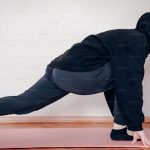Stressed? Busy? Juggling too many balls? Trying to tick off an endless ‘to-do’ list? This seems to be most of us, especially if we’re lucky enough to live in the buzzing capital city of London.
What with work, family, a social life, and the mental load that comes with that trio, it’s easy to let this frenetic ‘get-things-done’ attitude spill over into our yoga practice – ‘Done my morning yoga practice!’ ‘Tick!’
But deep down we know that yoga is more than just another item to tick off on the list. One way to access this deeper connection is to practice restorative yoga. This strand of yoga is one that we know we should do, but find that we habitually choose the more active, workout practice sessions. But if we can find the time, restorative yoga is the life-long present we can give ourselves – if we can turn our phones to airplane mode and ignore the outside world for long enough.
With this in mind, here’s the lowdown to all things ‘restorative yoga’.
What is restorative yoga?
Put simply, restorative yoga is a class involving poses that are done with support and held for longer periods of time. For this reason, a restorative yoga class will usually involve fewer poses. Restorative yoga sequences were first put together by B.K.S. Iyengar, one of the founding fathers of modern yoga, in his remedial classes. Using props that he had purpose-made, he put together sequences for those recovering from injury and illness. These sequences are the basis for restorative yoga classes that we find today.
Are yin yoga and restorative yoga the same thing?
These two forms of yoga are similar, especially to look at, but not the same. Formulated by Hatha yoga teacher, Paul Grilley, yin yoga is a cross between restorative hatha yoga and Taoist yoga called Tao Yin. In yin yoga classes, the postures are held for long periods in order to go deeper into the pose, stretching the connective tissue around the joints. Some yin yoga poses are ones that you wouldn’t do at a restorative yoga class, such as Eka Pada Rajakapotāsana (Pigeon Pose).
What’s the point?
The point of restorative yoga is to give the body space and time to consciously relax and restore itself. The body has an amazing capacity to heal itself, but when we’re rushing about fuelled by coffee and adrenaline, we don’t allow the body to tap into its own resources. The other point of restorative yoga is to prepare the body and mind for the next stage of the 8 limbs of yoga – pranayama. As B.K.S. Iyengar says:
“pranayama cannot become absorbing until body and mind are trained to receive the flow of breath”.
How does it work?
Restorative yoga works by taking the body out of ‘fight or flight’ mode and into ‘rest and digest’ mode – run by the parasympathetic nervous system. In this mode blood returns from the limbs (where it was needed for the fisticuffs and sprinting) to the digestive and reproductive organs. The heart rate and breathing slow down and the immune system now has the energy it needs to focus on doing a spring clean. Restorative yoga is also a way of giving ourselves a true rest.
Can we do it at home?
Yes – and we should! Although restorative yoga classes tend to involve a lot more props, it’s perfectly possible to adopt household items to fashion your own restorative yoga sequence. Many of the normal standing poses can be adapted to a restorative sequence by taking the back to the wall. The standing forward bends become restorative when the head is supported – preferably on something soft. Poses like ‘legs up the wall’ can be done anywhere that you can access a nice, flat bit of wall, and possibly a bit of support under your back, such as a mat or blanket. Forward bends that are held for longer periods with the head supported are restorative – take your head to a chair if you don’t have a yoga bolster. Those of us that have a home practice would really benefit from a restorative practice at least once a week.
Is restorative yoga easier?
No, it’s different. Restorative yoga isn’t yoga nidra (a form of meditation), where you lie down for the whole session. If you opt to go to a restorative yoga class under the impression that you’ll be lolling about you might be in for a shock. In the Iyengar yoga tradition, for example, restorative yoga sequences can be just as challenging as other classes, with the emphasis more on keeping the brain soft, but not necessarily the muscles. The other factor that makes restorative yoga hard is that we give ourselves the time to sit with our minds and teach them to become quiet and still. This is when the real work of yoga starts.













